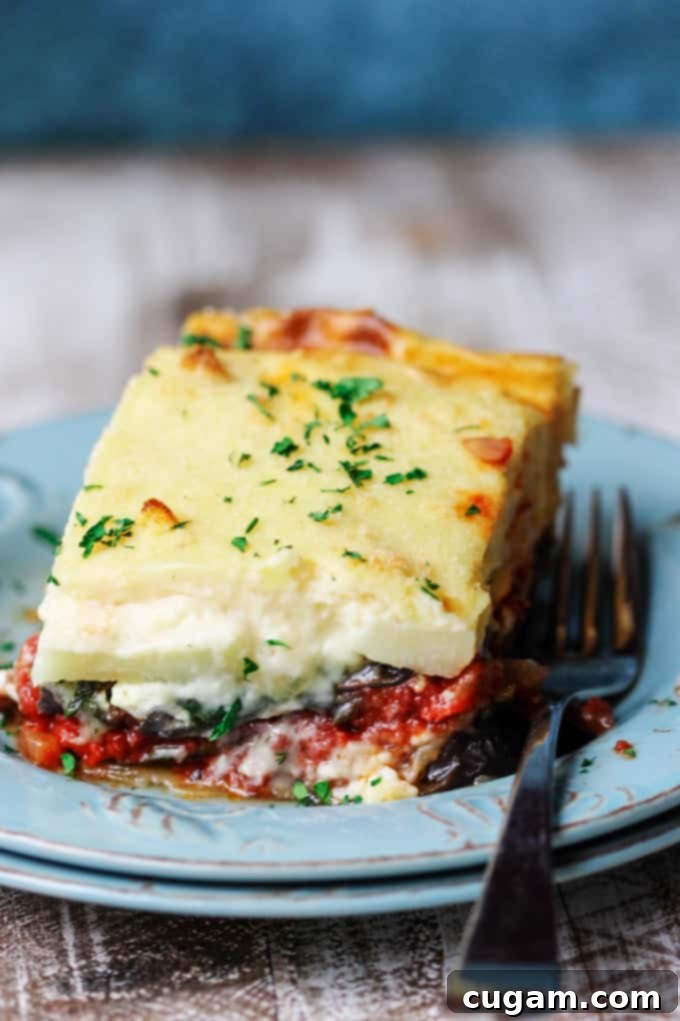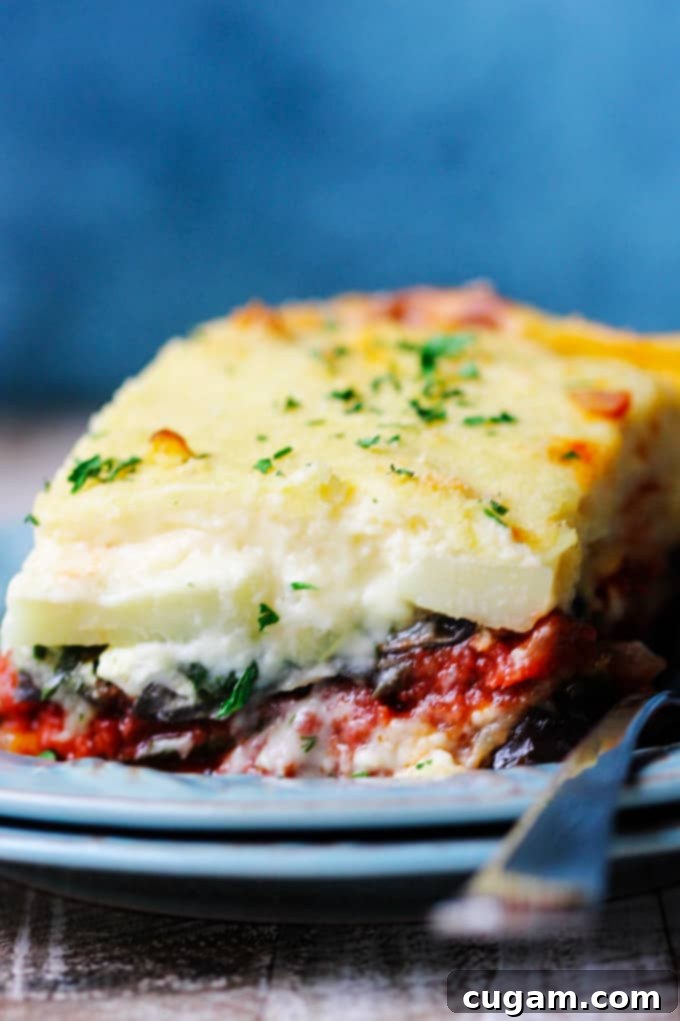Authentic Vegetarian Moussaka: A Rich & Creamy Greek Comfort Food Classic
Experience the heartwarming embrace of a true Greek classic, reimagined for plant-based perfection! This Vegetarian Moussaka is a vibrant tapestry of textures and tastes, featuring luscious layers of tender eggplant, earthy zucchini, fresh spinach, crumbled feta, and perfectly cooked potatoes. All these delightful components are generously coated in a fragrant, cinnamon-spiced tomato sauce and crowned with a golden, cheesy béchamel. Each forkful promises an unforgettable journey to the heart of Mediterranean cuisine, proving that meatless can be utterly magnificent.
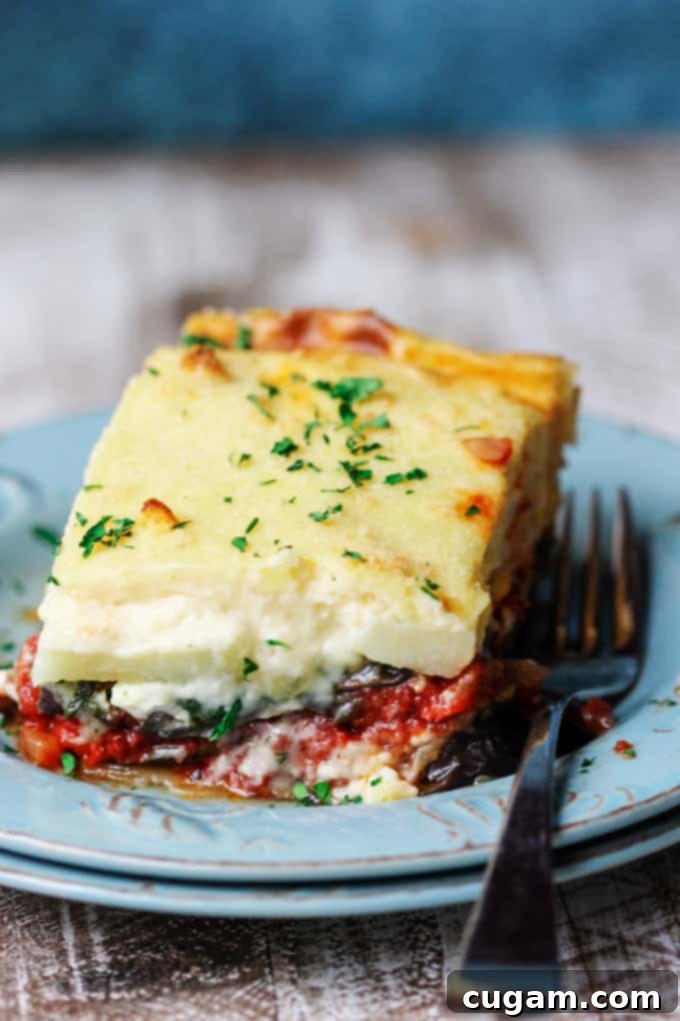 This post may contain affiliate links. You can read my disclosure policy here.
This post may contain affiliate links. You can read my disclosure policy here.
The traditional Greek Moussaka is renowned for its savory meat layer, typically made with seasoned ground beef or lamb, lovingly simmered in a rich tomato sauce. However, as more people seek to incorporate a healthier, more vegetable-rich diet into their lives, the demand for delicious meatless alternatives has grown. This recipe offers a delightful spin on the beloved classic, maintaining all the iconic flavors and comforting richness without the meat. It’s a fantastic way to enjoy a hearty, satisfying meal that’s both nourishing and incredibly flavorful.
My journey to creating this vegetarian moussaka was inspired by a personal goal to reduce meat consumption and introduce more wholesome vegetables into our family meals. While my husband usually gravitates towards meat-centric dishes and views “Meatless Mondays” with a healthy dose of skepticism, there’s one culinary category where he happily makes an exception: eggplant. Its versatile texture and ability to absorb flavors always win him over, making it my secret weapon for introducing vegetarian meals.
For instance, he enthusiastically enjoys dishes like this Slow Cooker Eggplant Lasagna and this Turkish Inspired Eggplant with Feta – both entirely vegetarian options that grace our dinner table without a single protest. Building on this success, I knew a vegetarian moussaka had the potential to be a real winner.
The first time I served this meatless moussaka, the silence at the dinner table was telling. My husband, the self-proclaimed carnivore, was utterly speechless. He savored every bite, completely absorbed in the exquisite layers and rich flavors. There were no complaints, no wistful sighs for meat – just pure, unadulterated enjoyment. Even our 19-month-old toddler, often a picky eater, devoured it with gusto! It was a resounding success, proving that this dish is not just a substitute, but a spectacular meal in its own right.
Now, I won’t pretend this is a quick, throw-it-all-in-one-pot kind of meal. Crafting the perfect moussaka requires a little extra time and effort – a labor of love, if you will. Each layer needs attention, but the process is incredibly rewarding. Think of it as an enjoyable culinary project that culminates in a truly show-stopping dish.
The end result is nothing short of outstanding. When you pull this golden, bubbling beauty from the oven, you’ll feel an immense sense of pride and accomplishment. I can almost guarantee that your family will be begging for this recipe to become a regular fixture in your meal rotation. Don’t let the multiple steps intimidate you; I’m here to guide you through a detailed, step-by-step tutorial below, ensuring your moussaka turns out perfectly every time.
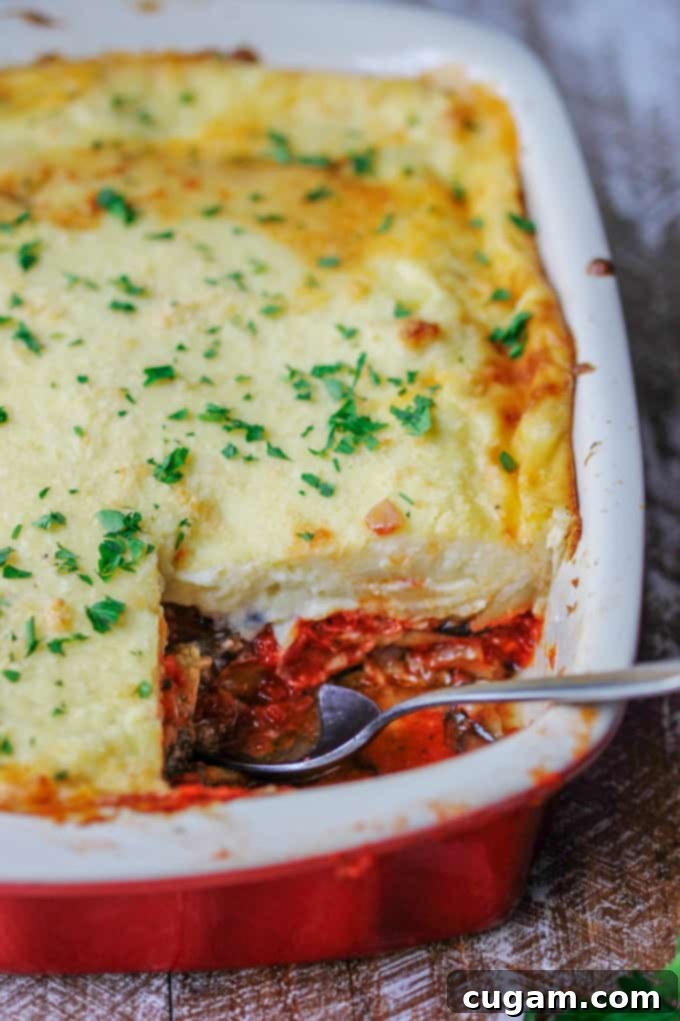
Essential Ingredients and Tools for Your Vegetarian Moussaka
Let’s dive right into what you’ll need to create this magnificent Vegetarian Moussaka. This recipe, while requiring several stages, is made simple with the right ingredients and tools. Taking a moment to organize everything before you begin will make the cooking process much smoother and more enjoyable.
Gather Your Ingredients: What You Need for a Flavorful Vegetarian Moussaka
Don’t be daunted by the length of this list; many of these items are likely staples you already have in your pantry or refrigerator. This comprehensive list is designed to help you prepare for a seamless grocery run and ensure you have every component for a truly authentic taste.
- Eggplants: The star of moussaka, providing a tender, meaty texture.
- Zucchinis: Adding another layer of fresh, subtle flavor and texture.
- Potatoes: A classic base, offering comforting starchiness to the layers.
- Spinach: Infuses the dish with vibrant color and nutrients.
- Feta Cheese: Crumbly, salty, and utterly essential for that authentic Greek tang.
- Onions & Garlic: Aromatic foundational ingredients for all savory layers.
- Fresh Dill: Brightens the spinach layer with its unique herby note.
- Tomato Puree: Forms the rich, flavorful heart of the sauce.
- Butter & Flour: The essential duo for a silky-smooth béchamel.
- Milk: The liquid base for the creamy béchamel sauce.
- Eggs: Used for binding in the spinach layer and enriching the béchamel.
- Parmesan Cheese: Adds a savory, nutty depth to the béchamel and a golden crust.
- Cinnamon & Oregano: The signature Greek spices that define moussaka’s aromatic profile.
- Nutmeg: A crucial, subtle spice for both the tomato sauce and béchamel.
- Sugar: Balances the acidity of the tomatoes.
- Salt & Pepper: Basic seasonings to enhance all the flavors.
- Olive Oil: For sautéing and brushing vegetables, an indispensable Mediterranean staple.
Having all these ingredients measured and ready will significantly streamline your cooking process, allowing you to focus on the art of layering this incredible dish.
Essential Tools: Your Kitchen Arsenal for Moussaka Success
We are a participant in the Amazon Services LLC Associates Program, an affiliate advertising program designed to provide a means for us to earn fees by linking to Amazon.com and affiliated sites.
To successfully navigate the creation of this layered masterpiece, a few key kitchen tools will be invaluable. Having these on hand will ensure each step, from vegetable preparation to final assembly, is executed with ease.
- Deep Sauté Pans (x2): One for wilting the spinach, another for crafting the aromatic tomato sauce. Depth is key for managing ingredients.
- Sheet Pans: Necessary for roasting the eggplant and zucchini slices evenly to a tender, golden finish.
- Medium Pot: For boiling the potato slices until they are perfectly tender.
- Large Mixing Bowl: Ideal for combining the spinach and feta layer.
- Saucepan/Frying Pan: Essential for preparing your luxurious béchamel sauce.
- Measuring Cups and Spoons: For precise ingredient measurements, ensuring perfect balance of flavors.
- Whisk: Crucial for achieving a lump-free, velvety béchamel sauce.
- Colander: For draining the boiled potatoes and ensuring no excess moisture.
- Pastry Brush: To lightly coat eggplant and zucchini with olive oil before roasting.
- A Reliable Set of Knives: Sharp knives are indispensable for slicing vegetables evenly. (These are my favorites; my husband gifted them to me for my birthday!)
- 9×13 Inch Casserole Dish: The ideal size and shape for assembling and baking your magnificent moussaka. A deep dish is preferable to accommodate all the glorious layers.
With these tools and ingredients at your disposal, you’re well-equipped to embark on this culinary adventure!
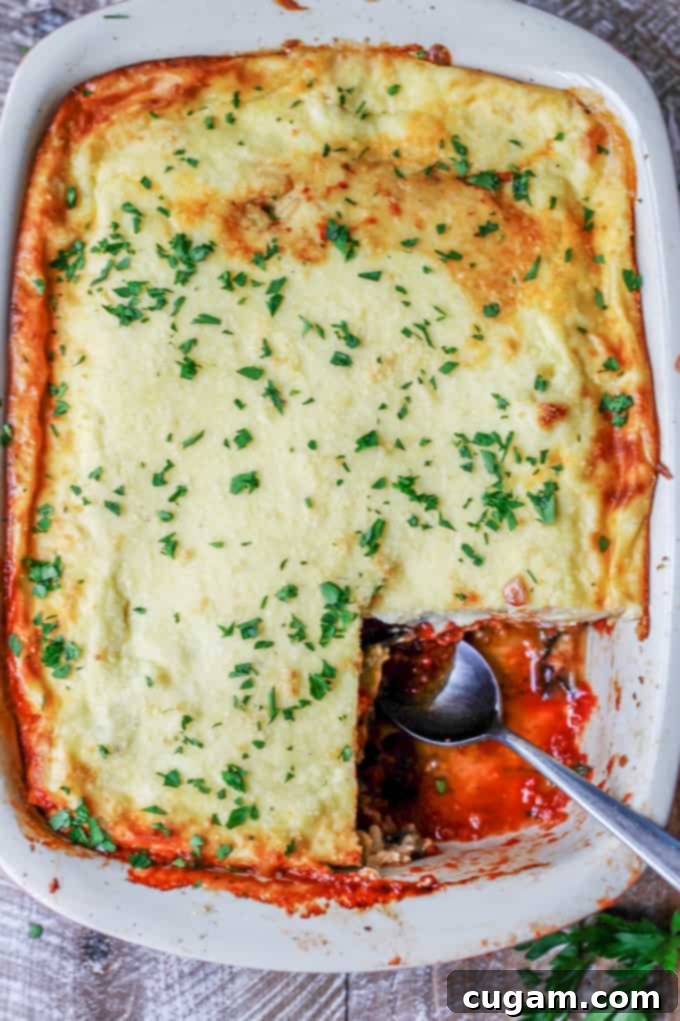
Step-by-step tutorial: How to Make Vegetarian Moussaka
For exact measurements, ingredients, detailed instructions, and nutritional information, please refer to the printable recipe card below. This tutorial is designed to provide a visual and descriptive guide to preparing this incredible dish.
Preparing the Vegetables: The Foundation of Your Moussaka
Properly preparing your vegetables is the first crucial step to a successful moussaka. This ensures they are tender, flavorful, and don’t introduce excess moisture into your casserole.
- Eggplant Preparation: Begin by slicing your eggplant into uniform rounds, about 1/2 inch thick. Arrange them on a wire rack or paper towels, sprinkle generously with salt, and let them sit for at least 30 minutes. This process draws out excess moisture and bitterness, resulting in a creamier texture. Pat them thoroughly dry before proceeding. Next, brush both sides lightly with olive oil, season with a pinch of pepper, and arrange on baking sheets. Roast in a preheated oven at 400°F (200°C) for 12-15 minutes, or until they are soft and slightly golden. Remove and let cool.
- Zucchini Preparation: Slice your zucchini to a similar thickness as the eggplant. Season with salt and pepper, brush both sides with olive oil, and place on a baking sheet. Bake alongside the eggplants for approximately 12-15 minutes, until tender. This roasting step prevents them from making the moussaka watery. Remove and let cool.
- Potato Preparation: Peel and slice your potatoes into thin rounds, about 1/4 inch thick. Boil them in lightly salted water until they are fork-tender, which usually takes around 10 minutes. Drain them well in a colander and allow them to cool completely. This pre-cooking ensures they will be perfectly soft in the final dish.
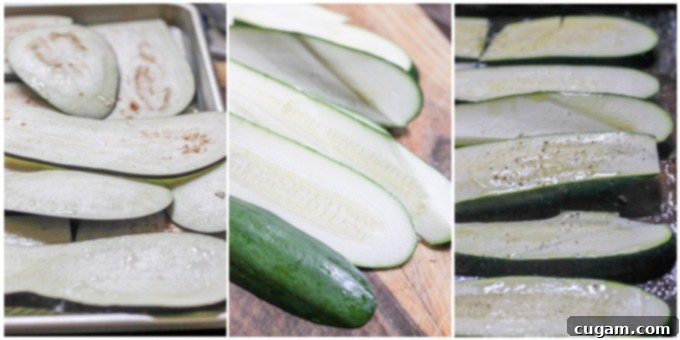
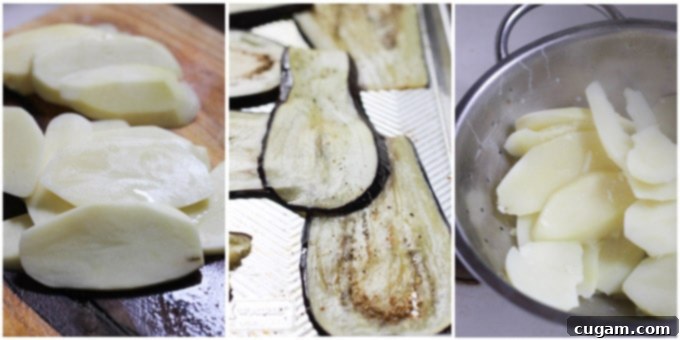
Crafting the Spinach and Feta Layer: A Burst of Mediterranean Flavor
This vibrant layer adds a delightful salty tang and a fresh herbaceous note, beautifully complementing the rich tomato sauce and creamy béchamel.
- Aromatic Base: Begin by finely chopping your onions and garlic.
- Sautéing Onions: In a deep skillet, heat a tablespoon of olive oil. Add the chopped onions and cook over medium heat for 2-3 minutes until they become translucent and fragrant.
- Adding Garlic: Stir in the minced garlic and cook for an additional minute, being careful not to burn it.
- Wilting Spinach: Add the fresh spinach to the skillet. Cook it down, stirring occasionally, until it is completely wilted and its volume has significantly reduced.
- Seasoning & Cooling: Stir in fresh dill, salt, and pepper. Remove from heat and set aside to cool completely. It’s important for the mixture to cool before the next step. Taste and adjust seasoning here, remembering that feta will add more saltiness.
- Egg & Feta Mixture: In a separate bowl, lightly beat 2 eggs. Add the crumbled feta cheese, a pinch of salt, and pepper.
- Combining Layers: Once the spinach mixture is cooled, add it to the bowl with the egg and feta. Mix everything thoroughly until well combined. Set this flavorful mixture aside.
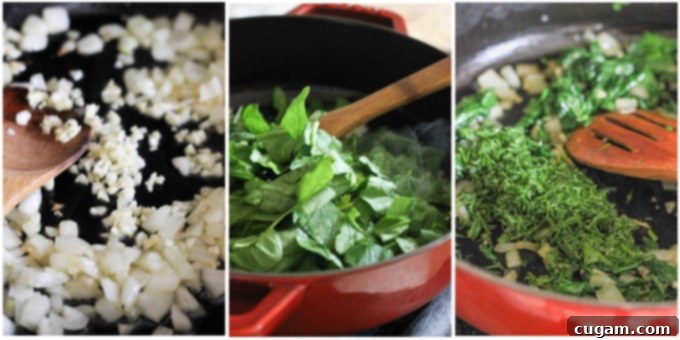
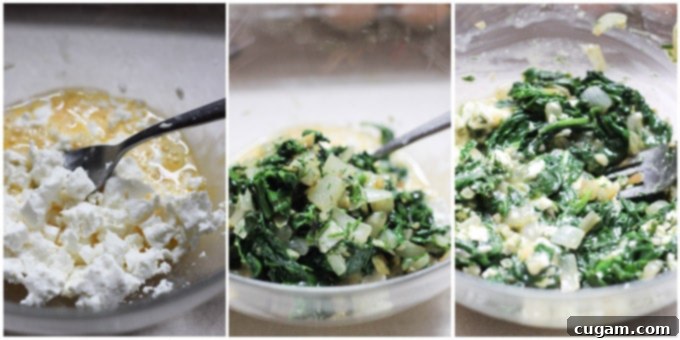
Developing the Tomato Sauce: The Heart of the Moussaka
This aromatic tomato sauce, subtly spiced with cinnamon, is what truly defines the flavor profile of moussaka, infusing it with warmth and a touch of sweetness.
- Building the Base: Just like with the spinach layer, start by heating olive oil in a deep sauté pan. Add the chopped onions and cook until translucent, about 2-3 minutes.
- Garlic Infusion: Add the minced garlic and cook for one more minute until fragrant.
- Spice Blend: Now, introduce the quintessential moussaka spices: cinnamon, nutmeg, and oregano. Sauté for about 30 seconds to allow their aromas to bloom.
- Tomato & Simmer: Pour in the pureed tomatoes, add a teaspoon of sugar (to balance acidity), salt, and pepper. Stir well, cover the pan, and let the sauce gently simmer for approximately 20 minutes. This allows the flavors to meld beautifully.
- Final Adjustment: Taste the sauce and adjust the seasoning as needed, adding more salt or pepper if desired.
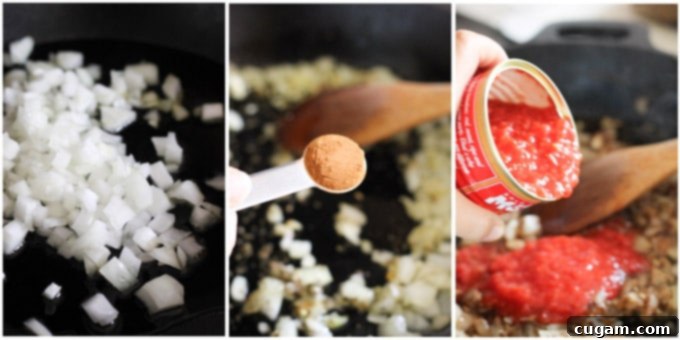
Creating the Silky Béchamel Sauce: The Creamy Crown
A perfectly smooth and rich béchamel is the hallmark of a great moussaka. It provides a luxurious, creamy finish that binds all the layers together.
- Making a Roux: In a clean saucepan or skillet, melt the butter over medium heat. Once melted, add the flour and whisk vigorously to create a smooth paste, or roux. Cook for 1-2 minutes, stirring constantly, to cook out the raw flour taste.
- Gradual Milk Addition: Slowly, gradually, start adding the milk, a little at a time, whisking continuously to prevent lumps. Continue until all the milk is incorporated and the sauce is smooth and thickened to your desired consistency. It should coat the back of a spoon.
- Seasoning: Season the béchamel with salt, pepper, and a pinch of nutmeg. Nutmeg is traditionally used in béchamel for moussaka and adds a wonderful aromatic touch.
- Remove from Heat: Turn off the heat.
- Adding Cheese & Eggs: Stir in the grated Parmesan cheese until it’s fully melted and incorporated. In a separate small bowl, beat 2 eggs and 1 egg yolk. Allow the béchamel to cool slightly for a few minutes before adding the eggs, then whisk them in thoroughly until the sauce is creamy and homogenous. This prevents the eggs from scrambling. Adjust final seasoning if necessary.
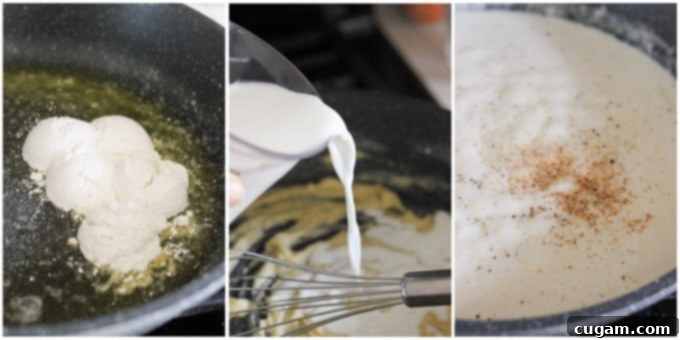

Assembling Your Vegetarian Moussaka: Layers of Perfection
This is where all your hard work comes together! Thoughtful layering ensures an even distribution of flavors and textures in every bite.
- Preheat Oven & Prepare Dish: Preheat your oven to 350°F (175°C). Lightly brush a 9×13 inch casserole dish with olive oil or spray it with cooking spray to prevent sticking.
- First Vegetable Layer: Arrange a single layer of roasted eggplant slices at the bottom of the dish, followed by a layer of roasted zucchini slices.
- Tomato Sauce: Evenly spread a generous amount of the cinnamon-spiced tomato sauce over the zucchini.
- Second Eggplant Layer: Add another layer of roasted eggplant slices.
- Spinach & Feta: Carefully spoon and spread the spinach and feta mixture over the eggplant.
- Potatoes: Arrange the boiled and cooled potato slices over the spinach-feta layer, ensuring good coverage.
- Béchamel Crown: Finally, pour the rich, creamy béchamel sauce evenly over the top of all the layers, spreading it gently to cover completely.
- Parmesan Finish: Sprinkle a bit more grated Parmesan cheese over the béchamel for a beautiful golden crust.
- Bake to Perfection: Bake in the preheated oven for 50-55 minutes, or until the top is golden brown and the moussaka is bubbly and heated through.
- Rest & Serve: This is a crucial step! Allow the moussaka to rest for at least 20 minutes after removing it from the oven. This helps the layers set, making it much easier to slice and serve cleanly. Then, slice and enjoy your magnificent creation!
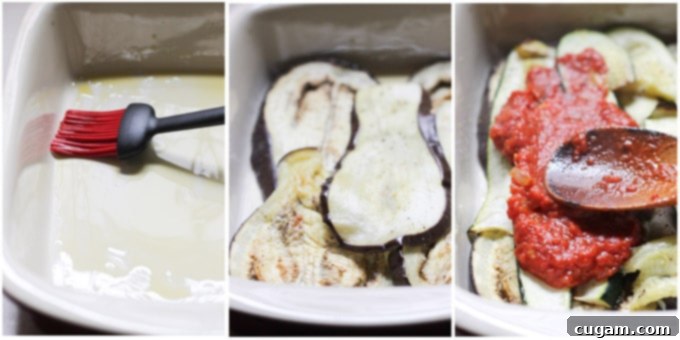
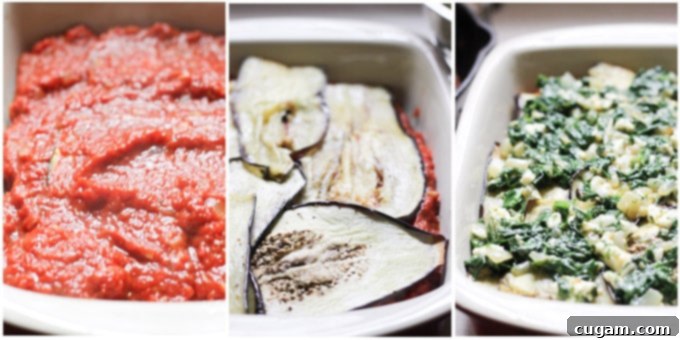
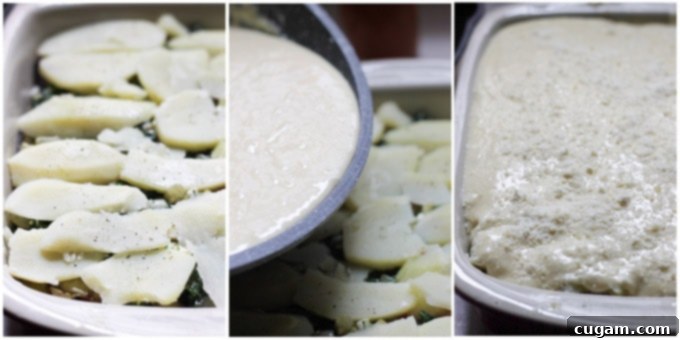
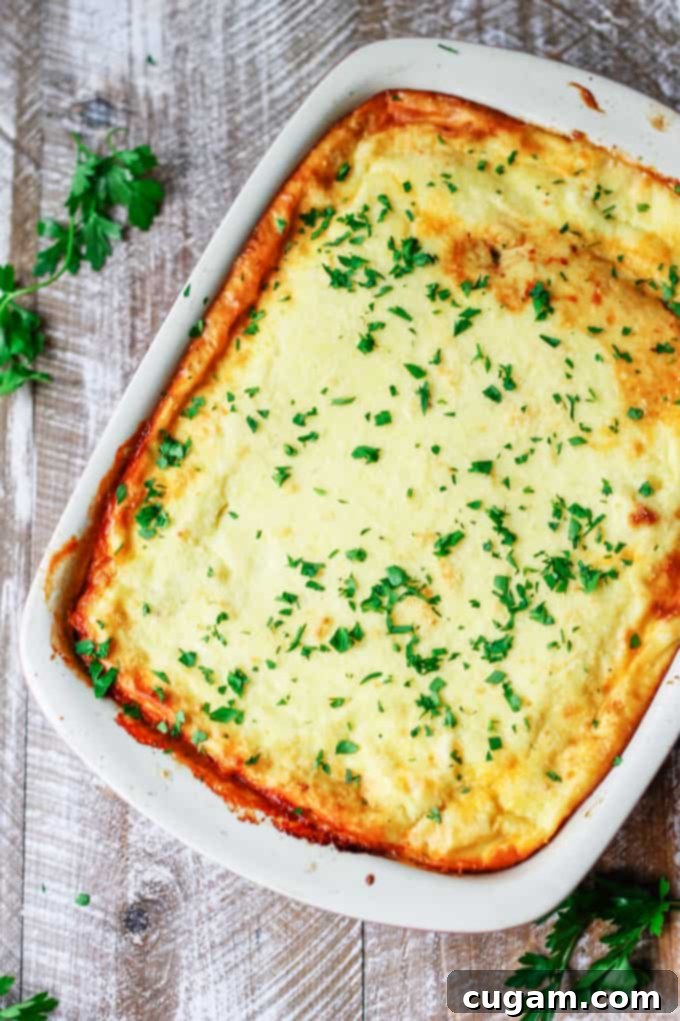
Tips for the Perfect Vegetarian Moussaka
- Salt the Eggplant: Don’t skip this step! Salting draws out excess moisture, which prevents the moussaka from becoming watery and helps the eggplant achieve a better texture when roasted.
- Roast, Don’t Fry: Roasting the eggplant and zucchini instead of frying them in oil makes the dish lighter and healthier, while still achieving a wonderful tenderness.
- Cool Your Sauces: Ensure your spinach-feta mixture and béchamel sauce cool slightly before adding eggs. This prevents the eggs from scrambling and ensures a smooth, creamy texture.
- Even Layers: Take your time to spread each layer evenly in the casserole dish. This ensures every slice of moussaka has a balanced proportion of all the delicious components.
- Resting Time is Key: It’s tempting to dive in right away, but allowing the moussaka to rest for 15-20 minutes after baking is crucial. This helps the layers set and prevents the dish from falling apart when sliced, resulting in cleaner, more beautiful servings.
What to serve this Vegetarian Moussaka with
This Greek vegetarian moussaka is a wonderfully complete meal on its own. It’s brimming with tender vegetables, satisfying starches, rich creaminess, and tangy cheeses, offering a perfect balance of flavors and essential nutrients. It’s hearty enough to be served as a standalone vegetarian main dish, and due to its abundance of vegetables, it often doesn’t even require a side salad.
However, if you’re looking to elevate the meal further or cater to diverse preferences, here are a few suggestions:
- For Meat Lovers: If you’re serving someone who absolutely craves meat with their meal, consider offering it alongside some easy oven-roasted chicken legs or a simple grilled chicken breast. The moussaka’s rich flavors pair surprisingly well with lean protein.
- A Fresh Salad Companion: To add a refreshing contrast, a crisp side salad is always a great choice. The Horiatiki salad (traditional Greek salad) with its fresh tomatoes, cucumbers, olives, and feta, makes for a perfect, authentic pairing.
- Creamy Tzatziki: You could also prepare some homemade tzatziki on the side. Its cool, garlicky, and cucumber-infused creaminess offers a delightful counterpoint to the rich baked moussaka.
- Warm Bread: A basket of warm, crusty bread or pita is excellent for soaking up any remaining sauce and completing the Mediterranean dining experience.
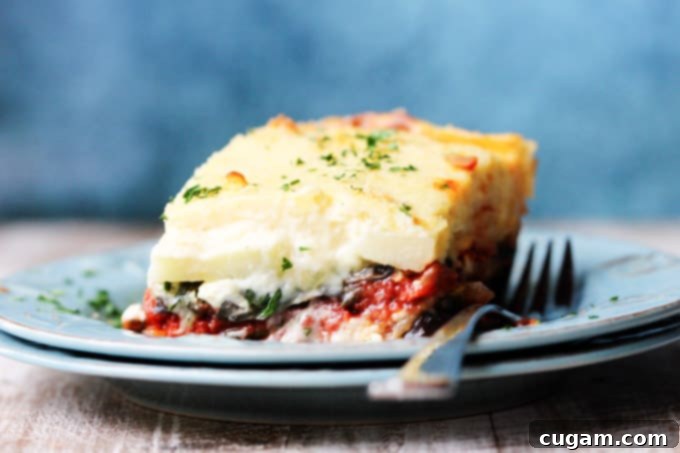
Explore More Greek Delights: Other Recipes You Might Love
If you’ve enjoyed this taste of Greece, you’ll be delighted to explore more traditional and authentic recipes from the region. From savory fritters to comforting soups, the Mediterranean diet offers a wealth of incredible flavors:
- Kolokithokeftedes – Crispy Greek Zucchini Fritters: A delightful appetizer or light meal.
- Kolokithopita – Hearty Greek Zucchini and Feta Pie: Another fantastic way to enjoy zucchini and feta.
- Greek Spinach Rice – Spanakorizo: A simple yet incredibly flavorful rice dish.
- Greek Chickpea Soup – Revithosoupa: A wholesome and satisfying vegetarian soup.
- Greek Lentil Soup – Fakes: A nutritious and hearty staple of Greek cuisine.
I genuinely hope this Vegetarian Moussaka recipe becomes a cherished favorite in your kitchen. It’s a dish that truly embodies comfort, flavor, and the vibrant spirit of Greek cooking. Enjoy the process, savor the flavors, and share this wonderful meal with your loved ones!
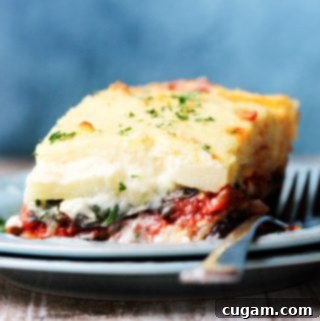
Vegetarian Moussaka – Classic Greek Casserole
Print
Pin
Rate
Ingredients
Vegetables
- 1 Large Eggplant
- 1 Large Zucchini or 2 small ones
- 4 Medium Russet Potatoes sliced
- 2 tbsp Extra Virgin Olive Oil
- Pinch of Salt and Pepper for sliced veggies
Spinach Feta Layer
- 3 cups Baby Spinach
- 1/2 Sweet Onion chopped
- 2 cloves Garlic chopped
- 2 tbsp Fresh Dill chopped
- 2 Eggs beaten
- 1 cup Crumbled Feta Cheese
- 1 tbsp Extra Virgin Olive Oil
- Salt and Pepper to taste
Tomato Sauce
- 1/2 Sweet Onion chopped
- 1 clove Garlic chopped
- 1/2 teaspoon Dry Oregano
- 1/2 teaspoon Cinnamon
- 1/4 teaspoon Nutmeg
- 2 cans Tomato Puree 14 oz each
- 1 teaspoon Sugar
- Salt and Pepper to taste
- 1 tbsp Extra Virgin Olive Oil
Bechamel Sauce
- 4 tbsp Unsalted Butter
- 5 tbsp All-purpose Flour
- 3 cups Milk Whole or 2 %
- 1/4 teaspoon Nutmeg
- 2 Eggs + 1 egg yolk
- 1/2 cup Grated Parmesan Cheese
- Salt and Pepper to taste
Instructions
Preparing Vegetables
-
Slice the eggplant, sprinkle with salt, and let sit for 30 minutes to draw out moisture. Pat dry. Brush both sides with olive oil, season with pepper, and roast on a baking sheet at 400F (200C) for 12-15 minutes until soft. Remove and cool.
-
Slice zucchini, season with salt and pepper, and brush with oil. Place on a baking sheet and bake with eggplants for 12-15 minutes until tender. Remove and cool.
-
Peel and slice potatoes. Cook in lightly salted boiling water for about 10 minutes until fork-tender. Drain in a colander and let cool.
Making Spinach and Feta Layer
-
Chop onions and garlic.
-
In a skillet, heat olive oil. Add onions and cook for 2-3 minutes until translucent.
-
Add garlic and cook for an additional minute.
-
Add spinach and cook until totally wilted.
-
Stir in fresh dill, salt, and pepper. Set aside to cool. Adjust seasoning carefully, as feta will add saltiness.
-
In a bowl, beat 2 eggs, then add crumbled feta, salt, and pepper.
-
Once spinach mixture is cooled, add it to the egg and feta bowl. Mix everything together thoroughly and set aside.
Making the Tomato Sauce
-
Start the tomato sauce with chopped onions and garlic, similar to the spinach layer.
-
Heat olive oil, add onions, and cook until translucent.
-
Add garlic and cook for one more minute.
-
Stir in the spices: cinnamon, nutmeg, and oregano.
-
Add pureed tomatoes, sugar, salt, and pepper. Cover and simmer for approximately 20 minutes.
-
Adjust seasoning (salt and pepper) to your taste.
Making the Béchamel Sauce
-
In a skillet, melt butter. Add flour and whisk vigorously to create a smooth roux.
-
Gradually add milk, whisking constantly until the sauce is smooth and thickened.
-
Season with salt, pepper, and nutmeg.
-
Remove from heat.
-
Stir in Parmesan cheese until melted.
-
Taste and adjust seasoning as needed.
-
Beat 2 eggs and 1 egg yolk, then slowly whisk into the slightly cooled béchamel sauce until thoroughly combined.
Assembling the Vegetarian Moussaka
-
Preheat oven to 350F (175C).
-
Brush a 9×13″ casserole dish with olive oil or cooking spray.
-
Layer eggplant slices, then top with zucchini slices.
-
Spread the tomato sauce evenly over the vegetables.
-
Add another layer of eggplant slices.
-
Add a layer of the spinach/feta mix.
-
Arrange the sliced potatoes over the spinach-feta layer.
-
Top everything with the béchamel sauce, spreading evenly.
-
Sprinkle with additional Parmesan cheese.
-
Bake for 50-55 minutes, until golden brown and bubbly.
-
Let it cool and set for about 20 minutes before serving. Enjoy!
Nutrition
Read about the author Edyta here or follow Eating European on social media: Facebook, Instagram, Pinterest, and Twitter.
